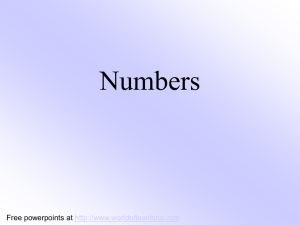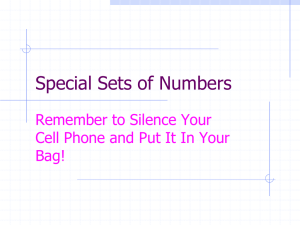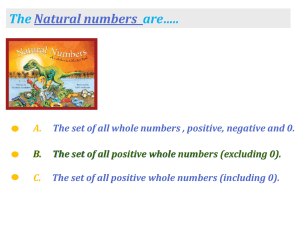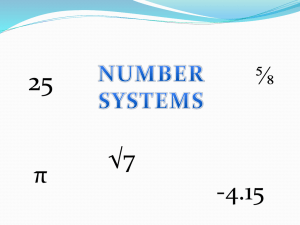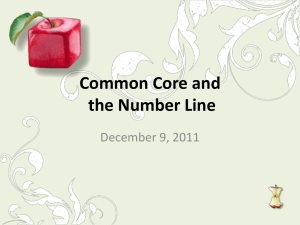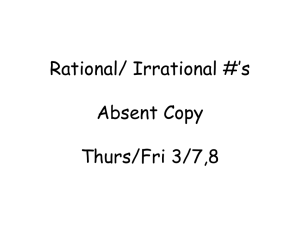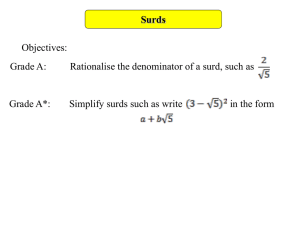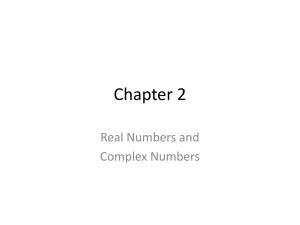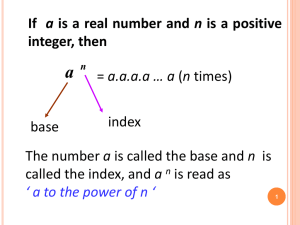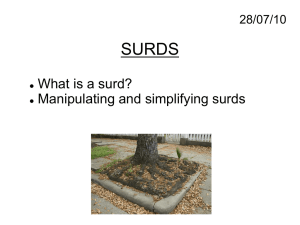Teaching number systems - from workshop 10
advertisement
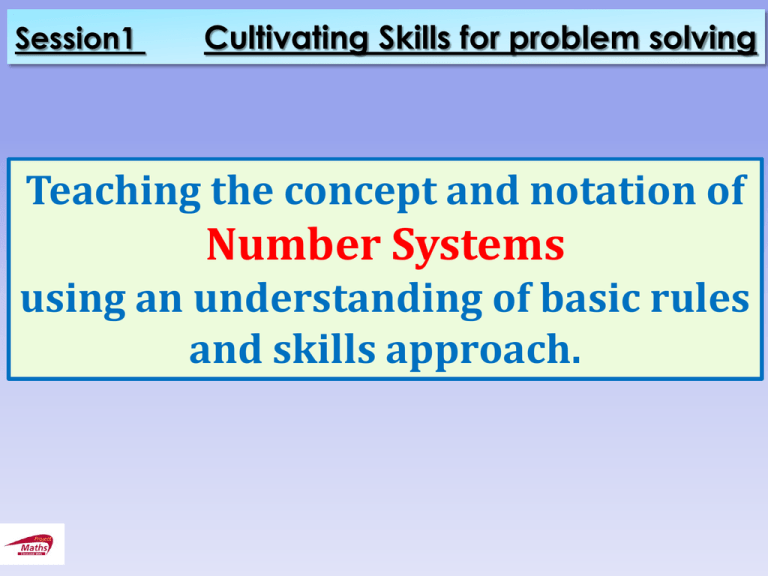
Session1 Cultivating Skills for problem solving Teaching the concept and notation of Number Systems using an understanding of basic rules and skills approach. Junior Certificate-All Levels Leaving Certificate- Foundation Level Leaving Certificate- Ordinary & Higher Level Section 1 Number Systems Prior Knowledge Within Curriculum Future Strands • Number Systems (ℕ, ℤ & ℚ) Subjects Across Real Past Strands World Assessment Quiz Time………… The Natural numbers are….. A. The set of all whole numbers , positive, negative and 0. B. The set of all positive whole numbers (excluding 0). C. The set of all positive whole numbers (including 0). The Integers are…… A. The set of all whole numbers , positive, negative and 0. B. The set of all positive whole numbers only. C. The set of all negative whole numbers only. Answer True or False to the following: ‘The natural numbers are a subset of the integers’. TRUE FALSE Which number is not an integer? A. -1 B. 0 C. 𝟕 𝟏 D. 4.𝟑 The Rational numbers are……. 𝒑 𝒒 A. Any number of the form , where p, q ∈ ℤ and q≠0. 𝒒 B. Any number of the form 𝒑 , 𝒒 Any number of the form 𝒑 , where 𝒒 C. where p, q ∈ ℤ . p, q ∈ ℕ . Which number is not a rational number? A. 0.3 Terminating Decimal B. 𝟐 𝟓 Terminating Decimal C. 𝟑 -1 𝟒 Terminating Decimal D. E. F. 𝟏𝟔 0.𝟏 Terminating Decimal Recurring Decimal 𝟐 =1.41421356237.. Decimal expansion that can go on forever without recurring Which number is not a rational number? The value of n for which 𝒏 is rational A. 2 B. 3 C. 5 D. 4 How many rational numbers are there between 0 and 1? A. 100 B. 10 C. Infinitely many D. 5 Answer True or False to the following: ‘All rational numbers are a subset of the integers’. TRUE FALSE Consider whether the following statements are True or False? Statement True or False Every integer is a natural number False Every natural number is a rational number True Every rational number is an integer False Every integer is a rational number True Every natural number is an integer True Which of the following venn-diagrams is correct? ℤ ℚ ℕ A. B. C. ℚ ℚ ℤ ℕ ℕ Natural ℕ ℤ ℕ and ℤ. Page 23 Venn Diagram & Number Line Natural ℕ Integers ℤ ℕ and ℤ. Page 23 Venn Diagram & Number Line ℤ A. ℚ\ℕ B. ℕ\ℤ C. ℤ\ℕ ℕ Page 23 Which symbol can we use for the ‘grey ‘ part of the Venn-diagram? Consider whether the following statement is Always, Sometimes or Never True ‘An integer is a whole number.’ Always Consider whether the following statement is Always, Sometimes or Never True ‘Negative numbers are Natural numbers.’ Never Consider whether the following statement is Always, Sometimes or Never True ‘The square of a number is greater than that number’ Sometimes Natural (N) Natural numbers (ℕ) &Numbers Integers (ℤ) Number Systems Natural numbers (ℕ) : The natural numbers is the set of counting numbers. ℕ = 1, 2, 3, 4, 5, … . . . The natural numbers is the set of positive whole numbers. This set does not include the number 0. Integers (ℤ) : The set of integers is the set of all whole numbers, positive negative and zero. ℤ = … . . −3, −2, −1, 0, 1, 2, 3, … . . . Page 23 Summary Rational Numbers (ℚ) A Rational number(ℚ) is a number that can be written 𝑝 as a ratio of two integers , where p, q ∈ ℤ & q≠ 0. 𝑞 A Rational number will have a decimal expansion that is terminating or recurring. Examples: a) b) c) 1 0.25 is rational , because it can be written as the ratio . 4 3 1.5 is rational , because it can be written as the ratio . 2 1 0.3 is rational , because it can be written as the ratio . 3 Interesting Rational Numbers 𝟓𝟑 𝟖𝟑 𝟏 𝟏 = 𝟎. 𝟏428𝟕 𝟕 = 𝟎. 𝟏𝟒𝟐𝟖𝟓𝟕𝟏𝟒𝟐𝟖𝟓𝟕𝟏𝟒𝟐𝟖𝟓𝟕 𝟎. 𝟕 𝟔385542168674698795180722 891566265060240𝟗 Literacy Considerations • • • • • • • • Word Bank Natural number Integer Rational number Ratio Whole Number Recurring/Repeating decimal Terminating decimal Subset ℕ, ℤ and ℚ. Page 23 Venn Diagram & Number Line Natural ℕ Integers ℤ ℤ\ℕ ℕ, ℤ and ℚ. Page 23 Venn Diagram & Number Line ℕ, ℤ and ℚ. Page 23 Venn Diagram & Number Line Rational ℚ ℚ\ℤ Rational ℚ 𝟑 𝟐 𝟒 𝟐 𝟓 𝟐 𝟔 𝟐 Page 23 𝟐 𝟐 Rational ℚ Page 23 𝟒 𝟓 𝟔 𝟕 𝟖 𝟗 𝟏𝟎 𝟏𝟏 𝟏𝟐 𝟒𝟒 𝟒 𝟒 𝟒𝟒 𝟒 𝟒 𝟒 Rational ℚ 𝟓 𝟒 𝟔 𝟒 𝟕 𝟒 𝟖 𝟒 Page 23 𝟒 𝟒 Rational ℚ Page 23 𝟖 𝟗 𝟏𝟎𝟏𝟏𝟏𝟐𝟏𝟑𝟏𝟒 𝟏𝟓𝟏𝟔 𝟖𝟖 𝟖 𝟖𝟖 𝟖𝟖 𝟖 𝟖 Rational ℚ 𝟏𝟎 𝟖 𝟏𝟐 𝟖 Page 23 𝟖 𝟖 Rational ℚ 𝟐𝟐 𝟐𝟒 𝟏𝟔 𝟏𝟔 Page 23 𝟏𝟔 𝟏𝟖 𝟐𝟎 𝟏𝟔 𝟏𝟔 𝟏𝟔 𝟐𝟐 𝟐𝟒 𝟏𝟔 𝟏𝟔 2 Rational ℚ Page 23 𝟏𝟔 𝟏𝟖 𝟐𝟎 𝟏𝟔 𝟏𝟔 𝟏𝟔 Learning Outcomes Number Systems Extend knowledge of number systems from first year to include: Within Curriculum Future Strands • IrrationalSubjects numbers • Surds Across Real • Past Real number system Strands World Junior Certificate-All Levels Leaving Certificate- Ordinary & Higher Level Student Activity 1 Calculator Activity Number (1) (2) 4 9 100 (3) 4 (4) 25 9 36 (5) 2 (6) 8 (7) 3 5 (8) 𝜋 (9) 1- 2 Calculator/ Decimals Student Activity 1 Calculator Activity Number (1) (2) 4 9 100 (3) 4 (4) 25 9 36 (5) 2 (6) 8 (7) 3 5 (8) 𝜋 (9) 1- 2 Calculator/ Decimals 2 Rational 3 0.3 Terminating 10 Or 2 0.6 Recurring 3 5 0.83 6 Irrational 1.414213562....2 1.41421356237309504…. Decimal 2.828427125…. 2.82842712474619009…. 2 2 expansion 1.70997594667669681…. 1.709975947…. 1.709975947 that can go on forever without 3.14159265358979323…. 3.141592654…. 𝜋 recurring -0.41421356237497912.… -0.4142135624… 1- 2 Irrational Numbers An Irrational number is any number that cannot be 𝑝 expressed as a ratio of two integers , where p and q ∈ ℤ 𝑞 and q≠0. Irrational numbers are numbers that can be written as decimals that go on forever without recurring. Page 23 So some numbers cannot be written as a ratio of two integers……. What is a Surd? A Surd is an irrational number containing a root term. Number 4 9 100 4 25 3 9 36 Calculator/ Decimals 2 0.3 2 3 5 0.83 6 0.6 2 1.414213562 2 8 2.828427125 2√2 5 1.709975947 𝜋 1- 2 3.141592654 𝜋 -0.4142135624 1- 2 Irrational Surd Best known Irrational Numbers Famous Irrational Numbers 𝝅 Pi : The first digits look like this 3.1415926535897932384626433832795…… 𝒆 Euler’s Number: The first digits look like this 2.7182818284590452353602874713527…. 𝝋 The Golden Ratio: The first digits look like this: 1.6180339887498948420……. √𝟐 Many square roots, cube roots, etc are also irrational numbers. 𝟐 = 1.4142135623746…… 𝟐 Pythagoras Hippassus 1.4142135623746…… Irrational Numbers Familiar irrationals 3 5 7𝑒 Rational ℚ Are these the only irrational numbers based on these numbers? 𝜋 Page 23 2 𝟐 𝟐 𝟕 𝟐 Rational 𝟑 𝟓 ℚ 𝟐 𝟐 𝒆 𝟐 𝝅 𝟐 3 5 7𝑒 𝜋 Page 23 2 Rational ℚ 7𝑒 𝜋 2 2 2 Page 23 5 2 Rational ℚ 7𝑒 𝜋 2 2 2 Page 23 5 2 Learning Outcomes Extend knowledge of number systems from first year to include: • Irrational numbers • Surds • Real number system Real Number System (ℝ) The set of Rational and Irrational numbers together make up the Real number system (ℝ). Real Number System (ℝ) Real ℝ 𝟖 𝟑+ 𝟓 Rational ℚ Irrational Numbers ℝ\ℚ Type equation here. − 𝟏𝟏 𝝅 𝟏− 𝟐 Student Activity Classify all the following numbers as natural, integer, rational, irrational or real using the table below. List all that apply. 5 Natural ℕ Integer ℤ Rational ℚ Irrational ℝ\ℚ Real ℝ 1+ 2 −9.6403915 … 1 −2 6.36 2 -3 3 8 0 - 3 Now place these numbers as accurately as possible on the number line below. Now place them as accurately as possible on the number What would help us here? line below. -10 -7.5 -5 -2.5 0 2.5 5 7.5 10 The diagram represents the sets: Natural Numbers ℕ, Integers ℤ, Rational Numbers ℚ 𝑎𝑛𝑑 Real Numbers ℝ. Insert each of the following numbers in the correct place on the diagram: 1 2 3 5, 1 + 2, −9.6403915. . … , − , 6.36 , 2𝜋, -3, 8, 0 and - 3. ℝ ℚ ℚ ℤ ℕ ℕ The diagram represents the sets: Natural Numbers ℕ, Integers ℤ, Rational Numbers ℚ 𝑎𝑛𝑑 Real Numbers ℝ. Insert each of the following numbers in the correct place on the diagram: 𝟏 −𝟗. 𝟔𝟒𝟎𝟑𝟗𝟏𝟓. . … , − 𝟐 5, 𝟏 + 𝟐, ℝ 1+ 𝟐 ℚ 6.𝟑𝟔 𝟐𝝅 - 𝟑 , 6.𝟑𝟔, 2𝝅 , -3, ℤ 𝟏 − 𝟐 ℕ -3 0 -9.6403915… 𝟑 𝟑 𝟖 𝟖 , 0 and - 𝟑. 5 Session 2 Investigating Surds Pythagoras Hippassus Show that 8 + 18 = 50 without the use of a calculator. Show that 8 8 + 18 = 50 without the use of a calculator. + 18 50 4x2 + 9x2 25 x 2 4 2 + 9 2 25 2 2 2 3 2 5 2 + 5 2 ⇒ 8 + 18 = 50 Investigating Surds Prior Knowledge • Number Systems (ℕ, ℤ ,ℚ, ℝ\ℚ & ℝ). • Trigonometry • Geometry/Theorems • Co-ordinate Geometry • Algebra Investigating Surds Plot A (0,0), B (1,1) & C (1,0) and join them. Write and Wipe Desk Mats Taking Formula Length a closer look (Distance) at surds graphically 𝑨𝑩 = Plot𝒙𝟐A−(0,0), 𝒙𝟏 𝟐 + 𝒚𝟐 −&𝒚𝟏 B (1,1) 𝟐 +join 𝑨𝑩 =C (1,0) 𝟏 − 𝟎and 𝟏 −them. 𝟎 𝟐 𝒚 𝑩 (𝟏, 𝟏) (𝒙𝟐 ,𝒚𝟐 ) 𝑨𝑩 = 𝟐 𝟏 𝟐Find + 𝟏|𝑨𝑩| 𝑨𝑩 = 𝟏 + 𝟏 𝑨 (𝟎, 𝟎) (𝒙𝟏 ,𝒚𝟏 ) 𝒙 𝑪 (1,0) 𝑨𝑩 = 𝟐 𝟐 Taking a closer Pythagoras’ Theorem look at surds graphically 𝒄𝟐 = 𝒂² + 𝒃² 𝒄𝟐 = 𝟏² + 𝟏² 𝒚 𝒄𝟐 = 𝟏 + 𝟏 𝒄 𝟏 𝒃 𝟏 𝒂 𝒄𝟐 = 𝟐 𝒙 𝒄𝟐 = 𝟐 𝒄 = 𝟐 Investigating Surds 1. Plot D (2,2) and E (2,0). 2. Join (1,1) to (2,2) and join (2,2) to (2,0). Write and Wipe Desk Mats Taking a closer Pythagoras’ Theorem look at surds graphically 𝑫 𝒄 𝟐 ? 𝟖 2 𝒂 𝑩 2 𝒃 2.𝒄𝟐 Join = 𝟐²(1,1) + 𝟐²to (2,2) and join (2,2) to (2,0). 3.𝒄𝟐 Find = 𝟒 |𝑨𝑫| +𝟒 𝒄𝟐 = 𝟖 𝒄𝟐 = 𝟖 𝑬 𝑨 𝟐 𝒄 = 𝒂² 𝒃² and E (2,0). 1. Plot D+ (2,2) 𝒄 = 𝟖 (1) Length Formula (Distance) (𝒙𝟐 ,𝒚𝟐 ) (2, 2) (𝒙𝟏 ,𝒚𝟏 ) 𝟐 𝑫 𝑨𝑩 = (𝒙𝟐 −𝒙𝟏 )²+ (𝒚𝟐 −𝒚𝟏 )² 𝑨𝑩 = (2− 1)² + ( 2− 1)² (1, 𝟏) 𝑩 𝑨𝑩 = (1)² + (1)² 𝑨𝑩 = 1 + |AB| = 𝟐 1 (2) Pythagoras’ Theorem D 𝑩 𝑪 𝒄𝟐 = 𝒂² + 𝒃² 𝑩𝑫 𝟐 = 𝟏² + 𝟏² 𝑩𝑫 𝟐 =𝟏+𝟏 𝑩𝑫 𝟐 =𝟐 𝑩𝑫 𝟐 = 𝟐 𝑩𝑫 = 𝟐 (2) Pythagoras’ Theorem 𝒄 𝒄𝟐 = a² + b² 𝟐 1 𝒂 1 𝒃 𝒄𝟐 =1²+ 1² 𝒄𝟐 = 1 + 1 𝒄𝟐 = 2 𝒄𝟐 = 𝟐 c = 𝟐 (3) Congruent Triangles SAS 𝟐 𝟐 1 1 1 1 Two sides and the included angle (4) Similar Triangles 𝑥 45° 𝒙 1 45° 𝟐 45° 1 45° 1 1 = 2 1 1 𝑥 2 =1 𝑥 1 2. = . 2 2 1 𝑥= 2 𝑎 sin 𝜃 = 𝑐 𝒙 𝒄 sin 450 𝒂 1 45° 𝑥. sin 450 1𝒃 1 = 𝑥 1 = .𝑥 𝑥 𝑥 sin 450 = 1 𝑎 sin 𝜃 = 𝑐 𝑏 cos 𝜃 = 𝑐 𝑎 tan 𝜃 = 𝑏 𝑥 sin 450 1 = 0 sin 45 sin 450 𝑥= 2 Page 16 (5) Trigonometry What are the possible misconceptions with Multiplication of surds 𝟐+ 𝟐? Graphically 𝟖 𝟐 𝟐 𝟖= 𝟐+ 𝟐 𝟖=𝟐 𝟐 Algebraically 𝟖=𝟐 𝟐 𝟖= 𝟒 𝟐 𝟒𝐱𝟐= 𝟒 𝟐 𝒂𝒃= 𝒂 𝒃 Division of Surds Graphically 𝟖 𝟐 𝟐 𝟖 𝟐 = 2 or 𝟖 𝟐 = 𝟐 𝟐 𝟐 Algebraically 𝟖 𝟐 𝟒𝟖𝐱 𝟐 == = 𝟒=𝟐 𝟐𝟐 𝟒 𝟐𝒂 𝒂 = =𝟐 𝒃 𝒃 = 𝟒 =𝟐 =𝟐 Student Activity-White Board Continue using the same whiteboard: (1) Plot (3,3). (2) Join (2,2) to (3,3) and join (3,3) to (3,0). (3) Using (0,0), (3,0) and (3,3) as your triangle verify that the length of the hypotenuse of this triangle is 18. (4) Simplify 18 without the use of a calculator. (5) Simplify 18 2 (6) Simplify 18 without 8 without the use of a calculator. the use of a calculator. Q1,2 &3 𝒄𝟐 = a² + b² c 𝒄𝟐 = 3²+ 3² 𝟏𝟖 3 3 b a 𝒄𝟐 = 9 + 9 𝒄𝟐 = 18 𝒄𝟐 = 𝟏𝟖 c = 𝟏𝟖 Q4 Simplify 18 without the use of a calculator. Graphically √2 𝟏𝟖 = 𝟏𝟖 √2 √2 3 𝟏𝟖 = 𝟐+ 𝟐+ 𝟐 𝟑 𝟐 Algebraically 𝒂𝒃 3 𝟏𝟖 = 𝒂 𝒃 = 𝟗 𝟐 𝟏𝟖 = 𝟑 𝟐 Q5. Simplify 18 2 without the use of a calculator. Graphically 𝟏𝟖 𝟐 𝟏𝟖 𝟐 𝟐 =3 Algebraically 𝟐 𝟏𝟖 𝟐 = = 𝒂 𝒃 = 𝟗 𝟏𝟖𝐱 𝟐 𝟐𝟐 𝟗 =𝟐 𝟗 = 3 = 𝟗=3 𝟐 𝒂 𝒃 Q6. Simplify 18 8 without the use of a calculator. Graphically 𝟏𝟖 𝟖 𝟏𝟖 𝟖 = 𝟑 𝟐 𝟏𝟖 𝟖 or = 𝟑 𝟐 𝟐 𝟐 = 𝟑 𝟐 Algebraically 𝟏𝟖 𝟖 = = 𝟗𝟏𝟖𝐱 𝟐 𝟖 = 𝟒𝐱𝟐 𝟗 𝟗𝐱𝟐 = 𝟒𝐱𝟐 𝟐 𝒂𝟒 𝟐 𝒂 𝟗= 𝒃 =𝒃 𝟒 = 𝟑 𝟐 𝟗 𝟒 𝟑 = 𝟐 What other surds could we illustrate if we extended this diagram ? 𝟐𝟐 =1=1𝟐 𝟐 𝟖𝟖 =2=2𝟐 𝟐 𝟏𝟖𝟏𝟖 =3=3𝟐 𝟐 𝟑𝟐=4=4𝟐 𝟐 𝟐 𝟑𝟐 𝟐 𝟐 𝟐 1 1 2 2 34 3 4 What other surds could we illustrate if we extended this diagram ? √2 =1√2 √8 =2√2 √18 =3√2 √32 =4√2 𝟓𝟎 𝟐 𝟐 𝟐 5 √50 = 5√2 𝟐 𝟐 5 √72 = 6√2 √98 = 7√2 √128 = 8√2 √162 = 9√2 √200 =10√2 Division of Surds Graphically 𝟓𝟎 𝟑𝟐 𝟓𝟎 𝟑𝟐 = 𝟓 𝟒 Algebraically 𝟓𝟎 𝟑𝟐 = 𝟐𝟓 𝑿 𝟐 = 𝟓 = 𝟒 𝟏𝟔 𝑿 𝟐 𝟐𝟓 𝟐 𝟏𝟔 𝟐 Show that 8 8 + 18 = 50 without the use of a calculator. + 18 50 4x2 + 9x2 25 x 2 4 2 + 9 2 25 2 2 2 3 2 5 2 + 5 2 ⇒ 8 + 18 = 50 𝟖 + 𝟏𝟖 2 𝟖𝟐 𝟑𝟏𝟖 𝟐 3 2 3 2 𝟖 + 𝟏𝟖 = 2 𝟐 +𝟑 𝟐 = 5 𝟐 𝟖 + 2𝟏𝟖𝟐 = = 𝟓 𝟓𝟎 + 𝟓𝟑 𝟐 𝟐= 𝟐 𝟓𝟎 Pythagoras Theorem 𝟐 𝟐 𝟓 𝟐𝟐 𝟓 𝟐 𝟐 𝟓 𝟖 + 𝟏𝟖 = 𝟓𝟎 𝟓 𝒄𝟐 = a² + b² 𝒄𝟐 = 2²+ 1² b 𝟓 1 c a 2 𝒄𝟐 = 4 + 1 𝒄𝟐 = 5 𝒄² = 𝟓 c = 𝟓 𝟑 𝒄𝟐 = a² + b² 𝟑 √3 11 𝒄𝟐 =( 𝟐)²+ 1² 𝒄𝟐 = 2 + 1 𝟐 𝒄𝟐 = 3 𝒄𝟐 = 𝟑 c = 𝟑 𝟓 𝟐𝟎 𝟓 2 𝟓 4 Graphically 𝟐𝟎 = 𝟓+ 𝟓 𝟐𝟎 = 𝟐 𝟓 Algebraically 𝟐𝟎 𝟐𝟎 = 𝟐 𝟓 = 𝟒 𝟓 𝟒𝑿𝟓 = 𝟒 𝟓 𝒂𝒃 = 𝒂 𝒃 𝟓 𝟒𝟓 𝟓 𝟓 𝟓 3 √45 6 Graphically 𝟒𝟓 𝟒𝟓 = 𝟓 + 𝟓+ 𝟓 = 𝟑 𝟓 Algebraically 𝟒𝟓 𝟒𝟓 = 𝟑 𝟓 = 𝟗 𝟓 𝟗𝑿𝟓 = 𝟗 𝟓 𝒂𝒃 = 𝒂 𝒃 Division of Surds Graphically 𝟒𝟓 =3 𝟓 𝟒𝟓 𝟓 Algebraically. 𝟒𝟓 𝟓 = = = 𝒂 𝟒𝟓 𝑿 𝟓 𝟗 𝟓 = 𝟗=3 𝟓 𝟗 𝟓 𝟓 𝒂 == 𝟗 𝒃 𝒃 = 3 1 1 1 𝟓 𝟒 𝟑 𝟔 1 The Spiral of Theodorus 1 1 𝟐 𝟕 𝟏𝟖 𝟖 1 𝟏𝟕 𝟗 1 1 1 𝟏𝟔 𝟏𝟎 𝟏𝟓 𝟏𝟏 𝟏𝟐 1 1 1 𝟏𝟑 1 𝟏𝟒 1 1 1 An Appreciation for students For positive real numbers a and b: • 𝑎𝑏 = 𝑎 𝑏 • 𝑎 𝑏 = 𝑎 𝑏 Adding /Subtracting Like Surds Simplifying Surds Spiral Staircase Problem Each step in a science museum's spiral staircase is an isosceles right triangle whose leg matches the hypotenuse of the previous step, as shown in the overhead view of the staircase. If the first step has an area of 0.5 square feet, what is the area of the eleventh step? Prior Knowledge 1 2 Area of a triangle= ah Solution Step 1 1 2 Step 2 1 b= 2 a a² = 1 ⇒𝑎=1 𝟐 1 2 𝟖 𝟐 2²=1 1 2 2 Multiplied by 2 (2)²=2 1 1 Area= sq.foot 2 Area= 1sq.foot 1 Step 1= 2 Step 2 = 1 Step 3 = 2 2 𝟐 1 2 Area Step 3 Area= 2sq.feet Step 4 =4 Step 5 =8 Step 6 =16 Step 7 =32 Step 8 =64 Step 9 =128 Step 10 =256 Step 11=512 Area (11th Step) 512sq.feet Solution 512 square feet. Using the area of a triangle formula, the first step's legs are each 1 foot long. Use the Pythagorean theorem to determine the hypotenuse of each step, which in turn is the leg of the next step. Successive Pythagorean calculations show that the legs double in length every second step: step 3 has 2-foot legs, step 5 has 4-foot legs, step 7 has 8-foot legs, and so on. Thus, step 11 has 32-foot legs, making a triangle with area 0.5(32)² = 512 sq. ft. Alternatively, students might recognize that each step can be cut in half to make two copies of the previous step. Hence, the area double with each new step, giving an area of 512 square feet by the eleventh step.
